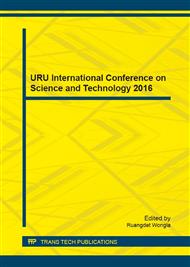[1]
C.P.M. Alfaia, S.P. Alves, A.F. Lopes, M.F.E. Fernandes, A.S.H. Costa, C.M.G.A. Fontes, M.L.F. Castro, R.J.B. Bessa, J.A.M. Prates, Effect of cooking methods on fatty acids, conjugated isomers of linoleic acid and nutritional quality of beef intramuscular fat, Meat Sci. 84 (2010).
DOI: 10.1016/j.meatsci.2009.11.014
Google Scholar
[2]
J.M. Lorenzo, A. Cittadini, P.E. Munekata, R. Domínguez, Physicochemical properties of foal meat as affected by cooking methods, Meat Sci. 108 (2015) 50-54.
DOI: 10.1016/j.meatsci.2015.05.021
Google Scholar
[3]
M. Juárez, S. Failla, A. Ficco, F. Pena, C. Avilés, O. Polvillo, Buffalo meat composition as affected by different cooking methods, Food Bioproducts Process. 88 (2010) 145-148.
DOI: 10.1016/j.fbp.2009.05.001
Google Scholar
[4]
D.A. King, M.E. Dikeman, T.L. Wheeler, C.L. Kastner, M. Koohmaraie, Chilling and cooking rate effects on some myofibrillar determinants of tenderness of beef, J. Anim. Sci. 81 (2003) 1473-1481.
DOI: 10.2527/2003.8161473x
Google Scholar
[5]
Q. Cheng, D.W. Sun, Factors affecting the water holding capacity of red meat products: A review of recent research advance, Critical Rev. Food Sci. Nutri. 48 (2008) 137-159.
DOI: 10.1080/10408390601177647
Google Scholar
[6]
J.M. Broncano, M.J. Petrón, V. Parra, M.L. Timón, Effect of different cooking methods on lipid oxidation and formation of free cholesterol oxidation products (COPs) in latissimusdorsi muscle of Iberian pigs, Meat Sci. 83 (2009) 431-437.
DOI: 10.1016/j.meatsci.2009.06.021
Google Scholar
[7]
F. Shahidi, Y. Zhong, Lipid oxidation and improving the oxidative stability, Chem. Soc. Rev. 39 (2010) 4067-4079.
DOI: 10.1039/b922183m
Google Scholar
[8]
A.I. Carrapiso, Effect of fat content on flavour release from sausages, Food Chem. 103 (2007) 396-403.
DOI: 10.1016/j.foodchem.2006.07.037
Google Scholar
[9]
D.V. Byrnea, W.L.P. Brediea, D.S. Mottram, M. Marten, Sensory and chemical investigation on the effect of oven cooking on warmed-over flavor development in chicken meat, Meat Sci. 61 (2002) 127-139.
DOI: 10.1016/s0309-1740(01)00171-1
Google Scholar
[10]
P. Hernández, J.L. Navarro, F. Toldrá, Lipids of pork meat as affected by various cooking techniques, Food Sci. Tech. Interl. 5 (1999) 501-508.
DOI: 10.1177/108201329900500608
Google Scholar
[11]
A.M. Salih, D.M. Smith, J.F. Price, I.E. Dawson, Modified extraction 2- thiobarbituric acid method for measuring lipid oxidation in poultry, Poultry Sci. 66 (1987) 1483-1488.
DOI: 10.3382/ps.0661483
Google Scholar
[12]
J.L. Myers, A.D. Well, Research Design and Statistical Analysis, Lawrence Erlbaum Associates, Inc., Publishers, New Jersey, (1995).
Google Scholar
[13]
R. Domínguez, M. Gómez, S. Fonseca, J.M. Lorenzo, Influence of thermal treatment on formation of volatile compounds, cooking loss and lipid oxidation in foal meat, LWT- Food Sci. Tech. 58 (2014) 430-445.
DOI: 10.1016/j.lwt.2014.04.006
Google Scholar
[14]
V. Kesava Rao, B.N. Kowale, N.P. Babu, G.S. Bisht, Effect of cooking and storage on lipid oxidation and development of cholesterol oxidation products in water buffalo meat, Meat Sci. 43 (1996) 179-185.
DOI: 10.1016/0309-1740(96)84589-x
Google Scholar
[15]
A. Conchillo, D. Ansorena, I. Astiasarán, Combined effect of cooking (grilling and roasting) and chilling storage (with and without air) on lipid and cholesterol oxidation in chicken breast, J. Food Prot. 66 (2003) 840-846.
DOI: 10.4315/0362-028x-66.5.840
Google Scholar
[16]
M.N. O'Grady, R. Carpenter, P.B. Lynch, N.M. O'Brien, J.P. Kerry, Addition of grape seed extract and bearberry to porcine diets: Influence on quality attributes of raw and cooked pork, Meat Sci. 78 (2008) 438-446.
DOI: 10.1016/j.meatsci.2007.07.011
Google Scholar
[17]
V. Nair, C.L. O'Neil, P.G. Wang, Malondialdehyde, e- Eros encyclopedia of reagents for organic synthesis, 2008, http: /dx. doi. org/doi: 10. 1002/047084289x. rm013. pub2.
Google Scholar


